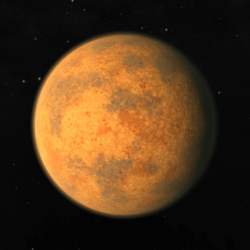TRAPPIST-1c
Tampilan
 Penggambaran ilustrator atas TRAPPIST-1c. (Februari 2018) | |
| Penemuan | |
|---|---|
| Tanggal penemuan | 2 Mei 2016 |
| Transit | |
| Ciri-ciri orbit | |
| Apastron | 0,015919 +0,000028−0,00003 AU |
| Periastron | 0,015712 +0,000028−0,00003 AU |
| 0,01581512 ± 1,5 × 10−7[1] AU | |
| Eksentrisitas | 0,00654 (± 0,00108)[1] |
| 2,42180746 (± 0,00000091)[2] h | |
| Inklinasi | 89,70 (± 0,18)[2] |
| Bintang | TRAPPIST-1[3] |
| Ciri-ciri fisik | |
Jari-jari rata-rata | 1,095 +0,031−0,030[1] R⊕ |
| Massa | 1,156 +0,131−0,142[1] M🜨 |
Massa jenis rata-rata | 4,87 +0,43−0,46 g/cm3 g cm−3 |
| 0,966 +0,087−0,092[1] g | |
| Suhu | 3.348 ± 47 K (3.074,8 ± 47,0 °C; 5.566,7 ± 84,6 °F) (kesetimbangan; untuk albedo nol)[2] |

TRAPPIST-1c adalah sebuah planet ekstrasurya yang mengorbit di sekitar bintang katai ultradingin TRAPPIST-1 sekitar 40 tahun cahaya jauhnya di konstelasi Aquarius.
Kelaikhunian
Adalah mungkin bahwa kehilangan air yang terjadi sebelum peredupan bintang yang membawa planet dalam zona laik huni.[4] diperkirakan bahwa TRAPPIST-1b dan TRAPPIST-1c mungkin telah kehilangan hingga empat Bumi Lautan mungkin mengorbankan huni, tetapi TRAPPIST-1d mungkin telah mampu menjaga cairan yang cukup air untuk mempertahankan hidup.
Referensi
- ^ a b c d e Grimm, Simon L.; Demory, Brice-Olivier; Gillon, Michael; Dorn, Caroline; Agol, Eric; Burdanov, Artem; Delrez, Laetitia; Sestovic, Marko; Triaud, Amaury H.M.J.; Turbet, Martin; Bolmont, Emeline; Caldas, Anthony; de Wit, Julien; Jehin, Emmanuel; Leconte, Jeremy; Raymond, Sean N.; Van Grootel, Valerie; Burgasser, Adam J.; Carey, Sean; Fabrycky, Daniel; Heng, Kevin; Hernandez, David M.; Ingalls, James G.; Lederer, Susan; Selsis, Franck; Queloz, Didier (2018). "The nature of the TRAPPIST-1 exoplanets". Astronomy & Astrophysics. 613: A68. arXiv:1802.01377
 . Bibcode:2018A&A...613A..68G. doi:10.1051/0004-6361/201732233.
. Bibcode:2018A&A...613A..68G. doi:10.1051/0004-6361/201732233.
- ^ a b c Delrez, Laetitia; Gillon, Michael; H.M.J, Amaury; Brice-Oliver Demory, Triaud; de Wit, Julien; Ingalls, James; Agol, Eric; Bolmont, Emeline; Burdanov, Artem; Burgasser, Adam J.; Carey, Sean J.; Jehin, Emmanuel; Leconte, Jeremy; Lederer, Susan; Queloz, Didier; Selsis, Franck; Grootel, Valerie Van (2018). "Early 2017 observations of TRAPPIST-1 with Spitzer". Monthly Notices of the Royal Astronomical Society. 475 (3): 3577–3597. arXiv:1801.02554
 . Bibcode:2018MNRAS.475.3577D. doi:10.1093/mnras/sty051.
. Bibcode:2018MNRAS.475.3577D. doi:10.1093/mnras/sty051.
- ^ Van Grootel, Valerie; Fernandes, Catarina S.; Gillon, Michaël; Jehin, Emmanuel; Scuflaire, Richard; et al. (2018). "Stellar parameters for TRAPPIST-1". The Astrophysical Journal. 853: 30. arXiv:1712.01911
 . Bibcode:2018ApJ...853...30V. doi:10.3847/1538-4357/aaa023.
. Bibcode:2018ApJ...853...30V. doi:10.3847/1538-4357/aaa023.
- ^ Bolmont, Emeline; Selsis, Franck; Owen, James E.; Ribas, Ignasi; Raymond, Sean N.; Leconte, Jérémy; Gillon, Michael (2016). "Water loss from Earth-sized planets in the habitable zones of ultracool dwarfs: Implications for the planets of TRAPPIST-1". arΧiv:1605.00616 [astro-ph.EP].

